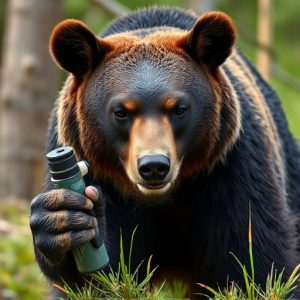Bear Spray vs Pepper Spray: Which is Stronger for Predator Defense?
Bear spray, with its higher capsaicin content than regular pepper spray, is a powerful deterrent aga…….
Bear spray, with its higher capsaicin content than regular pepper spray, is a powerful deterrent against large predators like bears. It creates an intense sensation and temporary blindness by overwhelming bear senses. When comparing the two, bear spray's unique formulation makes it significantly stronger due to its specific design for wildlife encounters. Responsible use requires understanding its purpose as a deterrence tool, proper training, and maintaining safe distances.
“Uncovering the power of bear spray as a defensive tool against predators is essential for outdoor enthusiasts and those living in wild regions. This article explores the effectiveness of bear spray, comparing its strength to traditional pepper spray. We delve into the science behind these products, their composition, and how they work. Learn about safety precautions and best practices for responsible use, ensuring you’re prepared for potential encounters. Understand why knowing the difference between bear and pepper spray is crucial for staying safe in the great outdoors.”
- Understanding Bear Spray: Composition and Effectiveness
- The Science Behind Pepper spray: Active Ingredients and Mechanisms
- Comparison: Bear Spray vs Pepper Spray Strength and Performance
- Using Bear Spray Responsibly: Safety Precautions and Best Practices
Understanding Bear Spray: Composition and Effectiveness
Bear spray, also known as bear repellent, is a crucial tool for individuals navigating wild environments where bears are present. Its composition varies from brand to brand, but typically includes capsaicin, the same compound found in chili peppers, along with other chemicals designed to deter bears. The effectiveness of bear spray lies in its ability to create an intense burning sensation and temporary blindness when sprayed directly into a bear’s face.
When comparing bear spray to pepper spray used for human self-defense, it’s evident that bear spray is generally considered more potent. While pepper spray targets the eyes and respiratory system with capsaicin, bear spray concentrates on creating a psychological barrier by overwhelming the bear’s senses. This makes bear spray a more effective defense mechanism against larger predators like bears, which can weigh several hundred pounds and possess formidable strength.
The Science Behind Pepper spray: Active Ingredients and Mechanisms
Bear spray, also known as pepper spray specifically designed for wildlife defense, is a powerful tool for deterring aggressive predators. The science behind its effectiveness lies in its active ingredients and how they interact with the human (or animal) body. Unlike traditional pepper spray used for law enforcement, which primarily contains capsaicin, bear spray formulations are carefully crafted to be extra potent and targeted against large wildlife like bears.
The key active ingredient in most bear sprays is a synthetic form of capsaicin, often combined with other chemicals such as menthol or various alkyl amines. These compounds are irritants that trigger nerve endings, causing a strong, localized response. Unlike regular pepper spray, which can cause blinding tears and temporary blindness, bear spray is designed to induce a powerful coughing fit and temporary respiratory distress in animals like bears, allowing the user precious time to escape or defend themselves. The strength of bear spray is often measured in capsaicin units (CU), with higher CU indicating greater potency—and by extension, its potential to deter even the most formidable predators.
Comparison: Bear Spray vs Pepper Spray Strength and Performance
When comparing bear spray to pepper spray, one of the primary considerations is their strength and performance. Many people wonder, “Is bear spray stronger than pepper spray?” The short answer is that bear spray is designed with a higher concentration of capsaicin, the active ingredient responsible for the burning sensation associated with both types of spray. This higher concentration makes bear spray significantly more effective against large predators like bears, offering a longer range and a more powerful deterrent.
While pepper spray is still an effective self-defense tool against smaller aggressors, its capsaicin content pales in comparison to bear spray. Bear spray’s increased strength allows it to create a protective barrier that can deter an attack from larger animals, making it a superior choice for outdoor enthusiasts and individuals living in areas prone to predator encounters.
Using Bear Spray Responsibly: Safety Precautions and Best Practices
Using bear spray responsibly requires a deep understanding of safety precautions and best practices. First, it’s crucial to know that bear spray is designed for immediate use in case of an attack. Unlike other self-defense mechanisms, bear spray acts as a barrier by creating a cloud of capsicum, which can deter an attacking animal. However, it’s essential to recognize that bear spray is not stronger than pepper spray intended for human self-defense; its potency is tailored for wildlife deterrence.
When using bear spray, follow these guidelines: ensure proper training on how and when to deploy the spray, as incorrect usage might not be effective or could even exacerbate the situation. Maintain a safe distance from the bear, typically 20-30 feet, before activating the spray. Aim for the bear’s face and eyes to maximize its impact. After deployment, back away slowly while monitoring the bear’s reaction. Remember that bear spray is a tool of last resort; prevention through understanding bear behavior and carrying appropriate gear remains the primary line of defense.
Bear spray has emerged as a reliable defense mechanism against predators, offering a powerful yet non-lethal option for outdoor enthusiasts. While there’s much debate about whether bear spray is stronger than pepper spray, its unique composition and specialized design make it highly effective in deterring bears. By understanding the science behind its active ingredients and implementing responsible usage practices, individuals can enhance their safety in bear country. Remember, knowledge and preparation are key to navigating these encounters, ensuring a safer experience outdoors.


